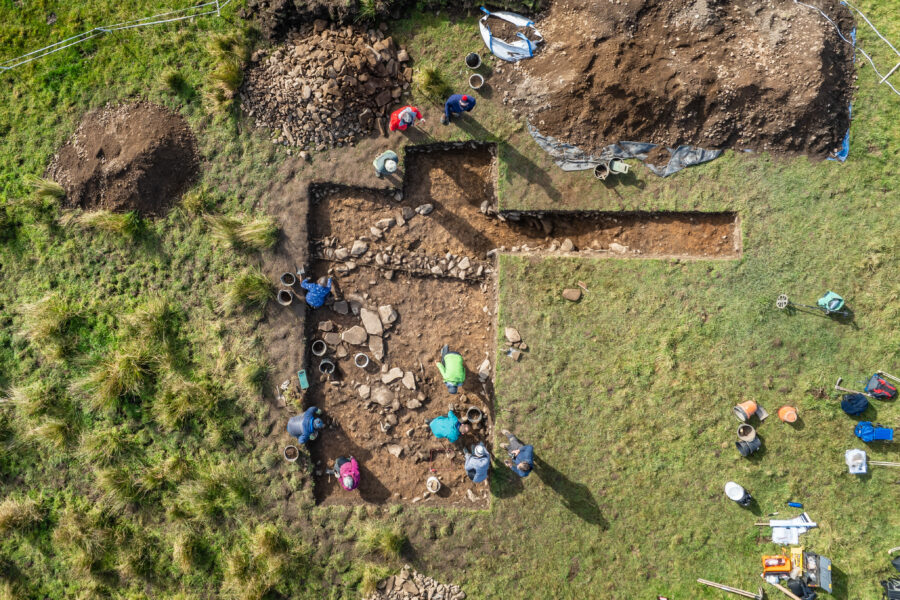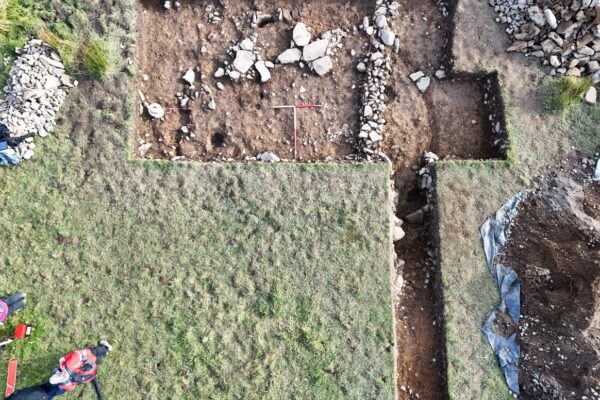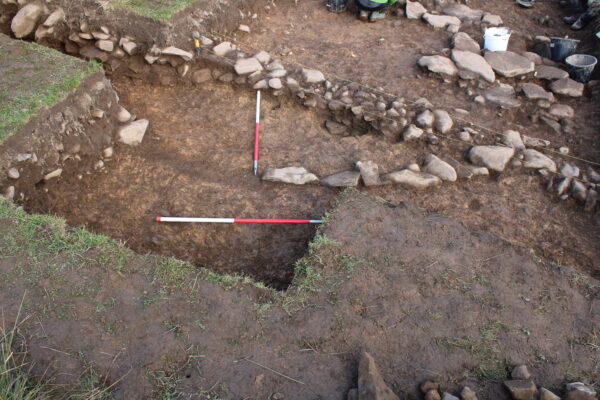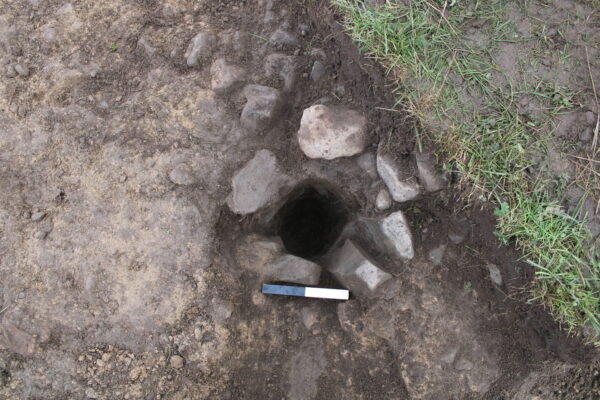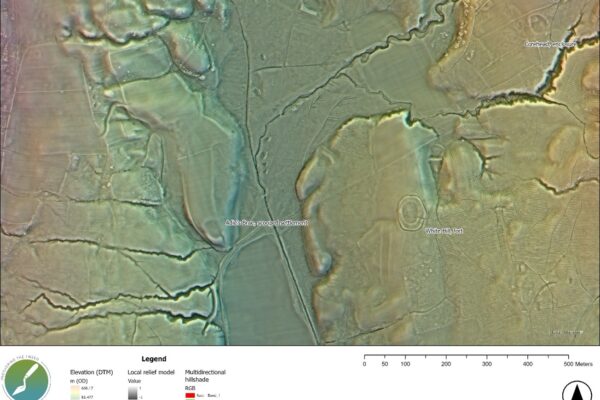Excavations at Adie’s Brae
Excavations at a scooped settlement north of Moffat in October 2024 have helped shed light on life in Southern Scotland in prehistory.
The landscape around Ericstane and Corehead, north of Moffat contains some very visible traces of the late prehistoric period, and represents a very good example of how prehistoric archaeology can survive around the fringes of improved cultivation and later forestry. Within a 2 km stretch along the Ericstane glen, at least three major forts and a further three scooped settlements are located on the margins of the fields found along the valley floor. Close to the modern A701, overlooking the valley floor, a well preserved section of Roman road cuts across the landscape, accompanied by a signal station. The Ericstane area comprises a busy Iron Age landscape, and must have been a key interface between Roman troops and native communities in the first century AD, and in the late 18th century, peat diggers found half of a Roman commander’s brooch close to the road (visit Moffat Museum to find out more).

About Scooped Settlements
Scooped settlements are a form of enclosed dwelling that seem to be active in the middle to late Iron Age period in Scotland, and it is probable that many were in use at the time of the Roman presence. They are a common site type in Annandale and along the Tweed, with some 40 examples known but, as with many common archaeological monuments in Scotland, relatively few have been excavated. For the most part, the inference of their dating has come from the fact that some evidently overlie the ramparts and ditches of much larger earlier Iron Age forts, and so therefore must be later.
Scooped settlements are usually sub-circular or oval, typically in the region of 40 to 60m across and with a heavy earth and stone bank or rampart forming an enclosure. They are termed ‘scooped’ because often their interiors are dug into a slope, with upcast used to form a level platform on which roundhouses were constructed. They normally enclose a small yard area, presumably where craft and food production and other domestic activities could take place, and perhaps where some livestock were kept.
Two examples which provide some of our evidence for these small middle/late Iron Age settlements are those excavated by Iain Banks at Woodend and by George Jobey at Boonies. At each of those settlements, sequences of timber-walled roundhouses overlay one another, some with small hearths and rough paving. Finds from these excavations included native and Roman pottery, querns and other coarse stone tools, glass bangles and other personal ornament, including a penannular brooch. All of the material likely dates to the first and second centuries AD.
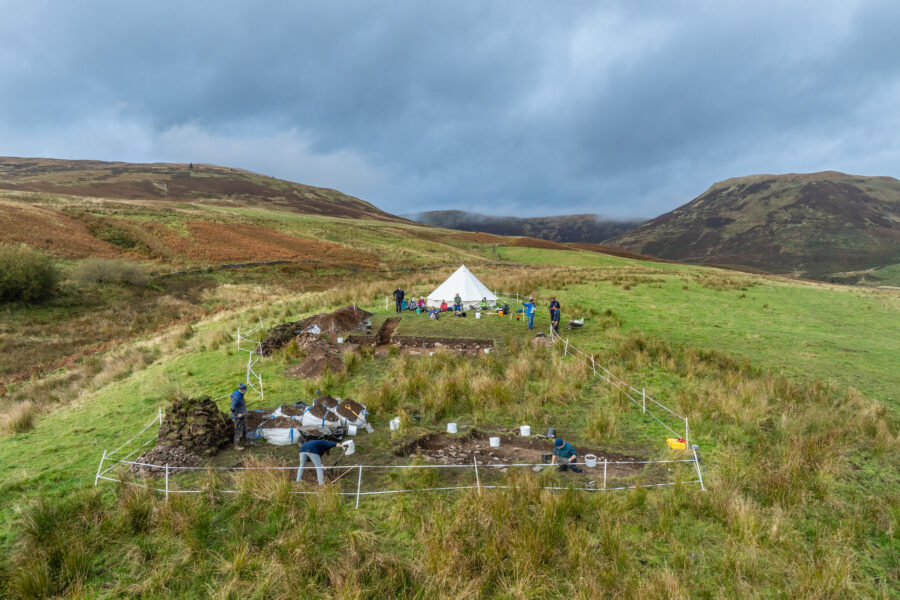
Investigating Adie’s Brae
Adie’s Brae is likely to be a related form of settlement, but no investigation at the site has ever been carried out until recently. In autumn 2024 Uncovering the Tweed collaborated with the landowner Borders Forest Trust to undertake a two week excavation of three trenches. The aim was to establish when the site was occupied and shed some light on the details of its construction and use. Our main research questions included:
- Is Adie’s Brae a settlement?
- When was it in use?
- How was it built and what would it have looked like?
- How did the occupants feed themselves? Was it a farmstead?
- Can we identify any other types of activity?
- If the settlement was in use in the early centuries AD, is there any evidence for Roman interaction?
The excavation of three trenches revealed the structural remains of at least two roundhouses with associated features including pits and postholes. These were set within the interior of the scooped settlement, towards the rear and centre. The enclosing bank for the scooped settlement was also investigated which comprised large angular greywacke stone in a dark silty sand matrix. This was entirely collapsed where excavated but is likely to have comprised an earthen bank with stone facing, at the top of a natural slope to the rear of the scooped settlement.
Several charcoal samples were retrieved that will provide radiocarbon dates for a range of features excavated. The artefactual assemblage was relatively small and included in situ fragments of iron objects, coarse stone tools, and a possible lead object. From the topsoil, fragments of a redware ceramic with a green glaze indicate later medieval or post-medieval use of the site while finds of flint and a chert core reflect earlier prehistoric activity.
What’s next?
Now the on site work is complete, the post-excavation programme is underway. Initially we will have soil samples processed to release any small ecofacts like burnt wood, burnt grain and seeds. Charcoal from secure contexts will be sent to SUERC lab to be dated which will help pin down the chronology of the site. Finds such as the iron objects and coarse stone tools will be analysed by our specialists. Eventually we will pull all this information together and be able to tell the story of Adie’s Brae and the community who lived there. The report will be available to download here in due course!
Further Reading
RCAHMS 1997 Eastern Dumfriesshire: an archaeological landscape (es. Pages 144- 155)
Banks, Ian 2000 ‘Excavation of an Iron Age and Romano-British enclosure at Woodend Farm, Johnstonebridge, Annandale, 1994 & 1997’ Proc Soc Antiq Scot 130
Jobey, G. 1974 ‘Excavations at Boonies, Westerkirk and the nature of Romano-British settlement in Eastern Dumfriesshire’ Proc Soc Antiq Scot 105
